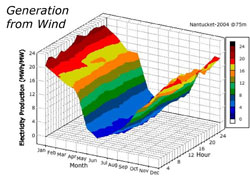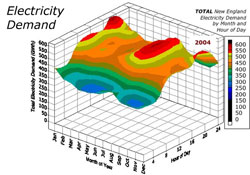
| Vol.
XXI No.
5 Summer 2009 |
| contents |
| Printable Version |
Energy Transitions and Transformations
This brief “op-ed” outlines some of the energy challenges and solutions that we have been conducting research on for over the past eight years – both at home and abroad – that simultaneously address the “substantial and sustained” reductions in both greenhouse gas as called for by world leaders (e.g., 80% by 2050) as well as other environmental threats, and energy security especially as it pertains to imported fossil fuels.
Note that this is not just a supply oriented technology view, nor just ways of increasing efficiency to reduce demand. Rather, we focus on integrated strategies that can provide substantial emissions reductions at large scale and in time. Thus a great deal of emphasis is focused on matching the dynamics of energy demands and supplies, and the role of large-scale demonstrations to gain consumer and industry confidence regarding innovative management options.
This piece focuses on key aspects of how we might transform the domestic U.S. energy market and the need for energy security, robust availability, and markets to bring about efficient use.
The United States, as well as many regions of the world, needs to protect itself economically and environmentally by substantially reducing fossil fuel consumption, especially imported fuels subject to increasingly volatile world energy markets. A strategy to transform a nation’s or region’s energy supply and demand infrastructure can be separated into three complementary components:
Aggressive End-Use Efficiency – Move aggressively to improve the efficiency of energy services, especially with new technologies that substitute information for energy (e.g., smart houses, grids, roads, etc.). An aggressive end-use efficiency strategy reduces the demand for energy and extends the usefulness of the energy delivery infrastructure.
Diversify Domestically – Greatly diversify the energy resources tapped by the energy sector to meet domestic energy needs. A large component of this diversification is a shift away from reliance on global fuel markets/supply-chains, to domestic energy resources comprised of both renewable and conventional carbon-free supplies.
Modernize Energy Networks – Modernize energy infrastructures by which those energy resources/supplies are transformed and delivered to consumers. This has near-, medium, and long-term components as we consider investments in the high-voltage grid to accept remote wind and/or clean coal, and the development of smart, local, microgrids capable of handling dynamic loads (demand response) and distributed generation and electricity storage. Analogous investments to improve the logistics of alternative fuel production and distribution will also be required.
Key to the design and implementation of such a strategy is a detailed understanding of local and regional dynamics, or situational aspects, of energy supply and demand (see figures next page for wind).
How national and state policies develop both new technologies and the business models required for their rapid deployment at all levels is a major design challenge.
This includes the electrification of transportation, the co-development of electric vehicles and fleets, smart grids enabling V2G (vehicle-to-grid), and also new clean generation to charge those vehicles. Economic stimulus benefits, and the need to rapidly develop the human capital necessary for this transformation, provide a substantial opportunity for the nation to move forward.
Demonstrations, Pilots, and Priming the Energy Industry for the Future
Near-term initiatives the new administration should consider include policies which simultaneously create business opportunities and jobs in the near term, and “prime the pump” for a low-carbon energy (not just electricity) future. Clearly the “Aggressive End-use Efficiency” component above provides the best early opportunities. This includes incentives to companies to retrofit buildings for lower energy consumption, but should also consider policies that provide a new foundation of construction activities promoting the renewal of the nation’s building stock, thereby insulating the construction business from frequent boom-bust cycles.
For the “Diversify Domestically” component, business and job creation is concentrated more at the levels of new projects/facilities, and will exhibit the dynamics seen in the wind industry over the past decade with the intermittent Production Tax Credit – all along the supply-chain – unless more steady and consistent policies are implemented. While state and federal policies supporting wind and solar have resulted in a large number of projects, investments, and the growth of the industry, to achieve the level of investments and growth envisioned to reduce greenhouse gases by 50-80% by mid-century, these policies need to be sustained and expanded

(click on image to enlarge)
As indicated in the U.S. Dept. of Energy’s 2008 “20% Wind Energy by 2030” vision report, we are only now beginning to look at the power grid investment requirements required to achieve “big wind.” The two surface plots of daily and seasonal New England electricity demand and offshore wind resources dynamics show the long-term challenges of matching electricity supplies and demands. Not shown, are both the short- and long-term variability and uncertainty of multiple renewable resources that need to be factored into future energy systems design.

(click on image to enlarge)
This is only one need of the future grid, and so “Modernizing Energy Networks” also balances network-wide investments which coordinate both growth and aging of the existing grid with new topologies to integrate remote wind and solar, remote carbon-capture and storage fossil, as well as highly dynamic distributed generation on lower voltage systems. While these may have limited job impacts in the near term, grid-by-grid analyses to identify network modernization (e.g., smart grid) strategies and investments need to begin in earnest now.
All together this level of effort clearly goes beyond a (large) handful of demonstration or pilot projects. In our work of the last several years, we have increasingly identified the need for “priming projects” or “integration demonstrations” which not only move the technologies forward, but develop the human capital and industry familiarity in siting, building, and operating these new technologies.
There are some significant “public goods” investments that governments also need to consider to develop and sustain this new energy industry. Education and training is one obvious need. Game changing and integration R&D is another. Often overlooked is the need to systematically collect geographically specific and high-resolution renewable resource data, so we can understand how much we can rely upon specific renewables, and to identify deployment thresholds we may encounter as they enter the energy system. Finally, there is also a need to develop “local and regional visions” that inform local communities of the economic and environmental benefits of large-scale penetration of renewables, smart grids, and to a lesser extent efficiency, to both combat NIMBY as well as to develop the local institutions essential to both create and sustain the jobs of a new energy future.
| Back to top | |
| Send your comments |
| home this issue archives editorial board contact us faculty website |